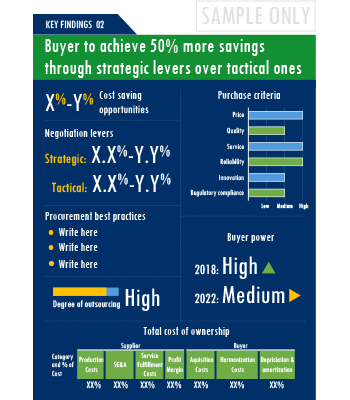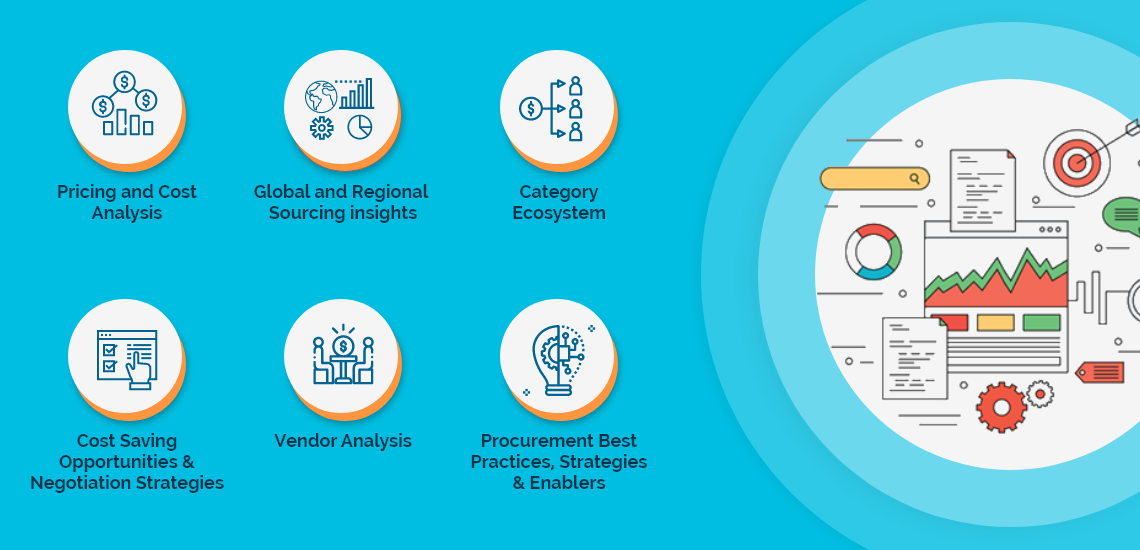A purchasing guide for Synchronous Dynamic Random Access Memory (SDRAM) – rich advisory on spend outlook in Synchronous Dynamic Random Access Memory (SDRAM), pricing analysis for Synchronous Dynamic Random Access Memory (SDRAM) procurement cost benchmarking, negotiation strategies and key vendors of Synchronous Dynamic Random Access Memory (SDRAM).
GET FREE SAMPLEThis report on global Synchronous Dynamic Random Access Memory (SDRAM) category is part of a larger series of reports on global Specialist Software and Hardware market. The scope of Specialist Software and Hardware spans multiple categories and is typically identified as a procurement category that includes all spend relating to the provision of non-common/bespoke software and hardware that are necessary for specific needs, and could not be used for other purposes.
The market for Specialist Software and Hardware and its sub-segments such as Synchronous Dynamic Random Access Memory (SDRAM) are at an interesting intersection. The supply market has undergone several structural changes including introduction of several new vendors every year, M&As and vertical integration efforts of suppliers. This has resulted in some issues such as erosion of previously established supplier relationships but has also opened new opportunities to onboard new suppliers that offer a solution with better fitment or a wider range of offerings in
Sometimes, procurement functions are unable to timely alter their practices while responding to market conditions. Industry experts acknowledge that periodically reviewing procurement best practices and adopting learnings from across procurement categories can help procurement teams respond to market needs in a more agile way. This report combines our experience of other categories with Synchronous Dynamic Random Access Memory (SDRAM) procurement insights and hand picks best practices that can work for category managers delving in this market. For example, Buyers must clearly define clauses pertaining to the ownership of subcontracting services that are not a part of preferred suppliers' portfolios. Subcontractors should be bound by the same terms and conditions as the main contractor to ensure consistency in quality and manage any adverse event such as data breach. Buyers should ask for a detailed account of the data protection capabilities of the supplier. In addition, buyers should also enquire regarding the redundancies available during instances of outages or disruptions. While some providers can provide backup, others may have limited capabilities in hardware redundancy. Prior to the commencement of contract-related discussions, buyers must ensure that they have clearly identified and listed down potential levers, such as duration of contract, resources required, space limits if relevant, terms of payment, expected resolution time, delivery point.
Activate your free account to gain easy access to cutting edge research and insights on consumers, emerging price trends, global and regional suppliers.
Synchronous Dynamic Random Access Memory (SDRAM) procurement managers also need to proactively identify and mitigate potential risks that can arise in the supply chain or contracts for Synchronous Dynamic Random Access Memory (SDRAM) procurement. Some examples include:
For detailed insights and complete access to our report library, activate your free account!
The report is intended to serve as a one-stop reference guide for Synchronous Dynamic Random Access Memory (SDRAM) procurement strategy and offers a perfect blend of category basics with deep-dive category data and insights. Therefore, it is ideal for category beginners looking for “Synchronous Dynamic Random Access Memory (SDRAM): Procurement Report 101” as well as for category experts actively tracking the global Synchronous Dynamic Random Access Memory (SDRAM) procurement market.
You may have just initiated your research to design a winning Synchronous Dynamic Random Access Memory (SDRAM) procurement strategy, or you may be a category expert looking for strategic insights and updated data.Either ways, the report has your requirements covered.

Unlock SpendEdge's comprehensive procurement report collection with ease through our procurement platform.
Procurement decisions can prove to be costly in the absence of careful deliberation and evaluation of every available option. In fact, more than 90% of the decision makers we work with acknowledge that timely availability of up-to-date category intelligence can help them make better purchasing decisions. More than 80% of them believe that in-house category intelligence needs to be updated periodically to achieve full benefits. If you have read so far, we are quite sure you agree!!
The Synchronous Dynamic Random Access Memory (SDRAM) procurement report helps take more informed decisions by placing all the critical information and advice at the fingertips of a decision maker. It also specifically answers some of the key questions that we have been routinely asked during our industry outreach initiatives:
SpendEdge Insights has helped procurement professionals and sourcing teams manage multiple spend areas and achieve more than $2 billion in savings. Activate your free account today!
The Synchronous Dynamic Random Access Memory (SDRAM) market report offers a complete picture of the supply market and analyzes the category from the perspective of both buyers and suppliers. Analysis of the category trends, procurement best practices, negotiation levers and overall category management strategy advisory are interspersed with in-depth data and commentary on spend outlook, pricing ecosystem and supplier landscape drilled down to a region-level coverage.

A key highlight of this report is the in-depth outlook created on Synchronous Dynamic Random Access Memory (SDRAM) procurement spend and pricing trends. The report further delves deep into the aspects of cost structure, total cost of ownership and supplier margins for Synchronous Dynamic Random Access Memory (SDRAM). A dedicated section to supplier profiles and evaluation helps decision makers cast a wider procurement net and identify gaps in existing relationships.

Along with specific category and supplier intelligence, the publication also includes curated insights on Synchronous Dynamic Random Access Memory (SDRAM) market trends, price influencers and inherent risks. These insights help the decision makers prepare for market shaping trends in advance and create alternative strategies for changes in the market conditions.

Additionally, the report also advises on the best practices and strategies to manage the Synchronous Dynamic Random Access Memory (SDRAM) category efficiently. Negotiation levers and opportunities are explained in detail along with quantification of their potential. Benchmark KPIs for supplier and buyer performance management are also aggregated to better organize the category objectives. Other themes of advisory include ideal procurement organization structure, enablers to achieve KPIs or category objectives and ideal SLAs to have with suppliers.






Our research is complex, but our reports are easy to digest. Quantitative analysis and exhaustive commentary is placed in an easy to read format that gives you an in-depth knowledge on the category without spending hours to figure out “what does it mean for my company?”


SpendEdge presents a detailed picture of Synchronous Dynamic Random Access Memory (SDRAM) procurement solutions by way of study, synthesis, and summation of data from multiple sources. The analysts have presented the various facets of the market with a particular focus on identifying the key category influencers. The data thus presented is comprehensive, reliable, and the result of extensive research, both primary and secondary.

Global Random Access Memory (RAM) Market - Procurement Intelligence Report

Global Synchronous Graphic Random Access Memory (SGRAM) Market - Procurement Intelligence Report

Global Dynamic Random Access Memory (DRAM) Market - Procurement Intelligence Report

Global Computer Platforms Market - Procurement Intelligence Report

Global Programmable Read Only Memory (PROM) Market - Procurement Intelligence Report

Global Read Only Memory (ROM) Market - Procurement Intelligence Report

Global Rambus Dynamic Random Access Memory (RDRAM) Market - Procurement Intelligence Report

Global Memory Expansion Services Market - Procurement Intelligence Report

Global Electronically Erasable Programmable Read Only Memory (EEPROM) Market - Procurement Intelligence Report
Access this report and our entire procurement platform | Plans starting from USD 3000/ Year Buy Now
Copyright © 2025 Infiniti Research Limited. All Rights Reserved. Privacy Notice – Terms of Use – Sales and Subscription
Cookie Policy
The Site uses cookies to record users' preferences in relation to the functionality of accessibility. We, our Affiliates, and our Vendors may store and access cookies on a device, and process personal data including unique identifiers sent by a device, to personalise content, tailor, and report on advertising and to analyse our traffic. By clicking “I’m fine with this”, you are allowing the use of these cookies. You may change your settings based on a legitimate interest at any time, by selecting “Manage Settings” on our site. Please refer to the help guide of your browser for further information on cookies, including how to disable them. Review our Privacy & Cookie Notice.
